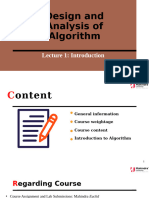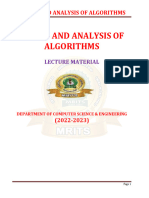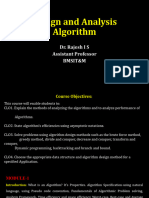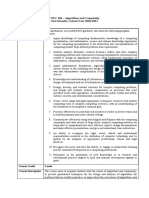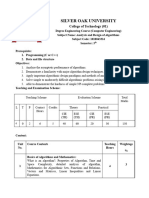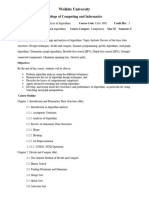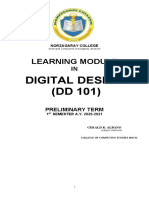0 ratings0% found this document useful (0 votes)
19 viewsIntroduction To Algorithms, Specification of Algorithm, Complexity
Uploaded by
Pratham AgarwalCopyright
© © All Rights Reserved
Available Formats
Download as PDF, TXT or read online on Scribd
0 ratings0% found this document useful (0 votes)
19 viewsIntroduction To Algorithms, Specification of Algorithm, Complexity
Uploaded by
Pratham AgarwalCopyright
© © All Rights Reserved
Available Formats
Download as PDF, TXT or read online on Scribd
You are on page 1/ 18
B.
TECH V SEM CSE
ACADEMIC YEAR: 2023-2024
Course Name: Design and Analysis of Algorithm
Topic: Introduction to Algorithms, Specification of Algorithm
Course code : CS 3102
Credits : 4
Mode of delivery : Hybrid (Power point presentation)
Faculty : Mr. Sunil Kumar Patel
Email-id : sunil.patel@jaipur.manipal.edu
CS3102 (DAA), Dept. of CSE 1
Assignment
quiz Assessment
Mid term examination criteria’s
End term Examination
CS3102 (DAA), Dept. of CSE 2
Introduction to Algorithms,
Asymptotic Notations, Complexity
CS3102 (DAA), Dept. of CSE 3
Course Information
• Course Handout
• Communicate through eMail
• Office hours
• To be communicated
• Grading policy
• Will be communicated as per university guidelines
CS3102 (DAA), Dept. of CSE
4
Syllabus
• Introduction: Fundamentals of Algorithms, Important Problem Types, Analysis
of algorithm efficiency. Analysis Framework: Asymptotic Notations and Basic
Efficiency Classes. Mathematical Analysis of Nonrecursive and Recursive
Algorithms: Brute force Techniques, Divide and Conquer. Decrease and
Conquer: Insertion Sort, Depth First Search, Breadth First Search, Topological
Sorting. Transform and Conquer: Presorting, BST, Heapsort. Space and Time
tradeoffs: Input Enhancement in String Matching. Dynamic Programming:
Warshall's and Floyd's Algorithms, The Knapsack Problem. Greedy Techniques:
Prim's, Kruskal's and Dijkstra's Algorithm, Huffman Trees. Coping with
limitations of algorithmic power. Backtracking: nQueens problem, Hamiltonian
Circuit Problem, Subset Sum Problem. Branch and Bound: Assignment
Problem, Knapsack Problem, TSP. P, NP, and NP-complete Problems.
CS3102 (DAA), Dept. of CSE
5
More Information
• Textbook
•Introduction to Algorithms 3rd ,Cormen,
Leiserson, Rivest and Stein, The MIT Press,
• Fundamentals of Computer Algorithms,
2nd, Sartaj Sahni, Ellis Horowitz,
Sanguthevar Rajasekaran
• Others
• Introduction to Design & Analysis Computer Algorithm 3rd,
Sara Baase, Allen Van Gelder, Adison-Wesley, 2000.
• Algorithms, Richard Johnsonbaugh, Marcus Schaefer, Prentice
Hall, 2004.
• Introduction to The Design and Analysis of Algorithms 2nd
Edition, Anany Levitin, Adison-Wesley, 2007.
CS3102 (DAA), Dept. of CSE
6
Course Objectives
• CS1501.1 Analyse the running times of algorithms using asymptotic analysis.
• CS1501.2 Demonstrate and Design algorithms using divide-and-conquer
paradigm to solve business problems hence enhance skills.
• CS1501.3 Illustrate the concept of greedy and dynamic-programming approach
to solve real life problems to enhance entrepreneurship capabilities.
• CS1501.4 Demonstrate the concept of backtracking and branch & bound
algorithms.
• CS1501.5 Synthesize and analyse various advanced algorithms concept such as
graphs, string matching, approximation algorithms and complexity classes to
enhance employability.
CS3102 (DAA), Dept. of CSE
7
Why study algorithms and
performance?
• Algorithms help us to understand scalability.
• Performance often draws the line between what is feasible
and what is impossible.
• Algorithmic mathematics provides a language for talking
about program behavior.
• Performance is the currency of computing.
• The lessons of program performance generalize to other
computing resources.
CS3102 (DAA), Dept. of CSE
8
Two Distinct Choices
CS3102 (DAA), Dept. of CSE
9
Applications
CS3102 (DAA), Dept. of CSE
10
Asymptotic Performance
• In this course, we care most about
asymptotic performance
• How does the algorithm behave as the
problem size gets very large?
• Running time
• Memory/storage requirements
• Bandwidth/power requirements/logic gates/etc.
CS3102 (DAA), Dept. of CSE
11
Goal of the Course
• Learning to solve real problems that arise
frequently in computer application
• Learning the basic principles and techniques
used for answering the question: “How good,
or, how bad is the algorithm”
• Getting to know a group of “very difficult
problems” categorized as “NP-Complete”
CS3102 (DAA), Dept. of CSE
12
Design and Analysis, in general
Design Analysis
•Understanding the goal •How does it work?
•Select the tools •Breaking a system down
to known components
•What components are
needed •How the components
relate to each other
•How the components
should be put together •Breaking a process down
to known functions
•Composing functions to
form a process
CS3102 (DAA), Dept. of CSE
13
Problem Solving
In general: Using computer:
Understanding the problem Describing the problem:
Selecting the strategy Selecting the strategy:
Giving the steps Algorithm:
Proving the correctness Input / Output/Step:
Trying to improve Analysis:
Correct or wrong
“good”or “bad”
Implementation:
Verification:
CS3102 (DAA), Dept. of CSE
14
Probably the Oldest Algorithm
CS3102 (DAA), Dept. of CSE
15
Euclid Algorithm: Recursive Version
CS3102 (DAA), Dept. of CSE
16
Algorithmically Solvable Problem
• Informally speaking
• A problem for which a computer program
can be written that will produce the correct
answer for any valid input if we let it run
long enough and allow it as much storage
space as it needs.
• Unsolvable(or un-decidable) problem
• Problems for which no algorithms exist
• the Halting Problem for Turing Machine
CS3102 (DAA), Dept. of CSE
17
Criteria for Algorithm Analysis
• Correctness
• Amount of work done
• Amount of space used
• Simplicity, clarity
• Optimality
CS3102 (DAA), Dept. of CSE
18
You might also like
- 008 Student Binary Math Worksheet ANSWER KEYNo ratings yet008 Student Binary Math Worksheet ANSWER KEY2 pages
- 1. Introduction to Algorithms, Specification of Algorithm, ComplexityNo ratings yet1. Introduction to Algorithms, Specification of Algorithm, Complexity35 pages
- BCA V and VI Sem Syllabus-As per UOM_Revised_08_04_24No ratings yetBCA V and VI Sem Syllabus-As per UOM_Revised_08_04_2430 pages
- Daa III II Notes 3 2 Design Analysis and AlgorithmsNo ratings yetDaa III II Notes 3 2 Design Analysis and Algorithms128 pages
- CS8451-DAA - by WWW - LearnEngineering.in PDFNo ratings yetCS8451-DAA - by WWW - LearnEngineering.in PDF120 pages
- Cse 408:design and Analysis of AlgorithmsNo ratings yetCse 408:design and Analysis of Algorithms97 pages
- CSPC 104 - Algorithms and Complexity 2nd Semester, School Year 2020-2021100% (1)CSPC 104 - Algorithms and Complexity 2nd Semester, School Year 2020-20213 pages
- Design and Analysis of Algorithms: CSE 5311 Lecture 1 Administration & IntroductionNo ratings yetDesign and Analysis of Algorithms: CSE 5311 Lecture 1 Administration & Introduction36 pages
- Week 01 Introduction to algorithms course - Shohag BarmanNo ratings yetWeek 01 Introduction to algorithms course - Shohag Barman45 pages
- Course Outline - DAA - CO@2023 dt-2024-02-22 20-38-49No ratings yetCourse Outline - DAA - CO@2023 dt-2024-02-22 20-38-493 pages
- University of South Asia - Faculty of Computer Sciences Course Outline Design and Analysis of AlgorithmsNo ratings yetUniversity of South Asia - Faculty of Computer Sciences Course Outline Design and Analysis of Algorithms4 pages
- Cs816: Design and Analysis of Algorithms (Daa) : (Professional Elective-I For M.Tech CSE)No ratings yetCs816: Design and Analysis of Algorithms (Daa) : (Professional Elective-I For M.Tech CSE)1 page
- 01ce0503 Design and Analysis of Algorithm 1No ratings yet01ce0503 Design and Analysis of Algorithm 14 pages
- Theory of Computation: Computer ScienceNo ratings yetTheory of Computation: Computer Science134 pages
- The 8051 Microcontroller & Embedded Systems: Muhammad Ali Mazidi, Janice Mazidi & Rolin MckinlayNo ratings yetThe 8051 Microcontroller & Embedded Systems: Muhammad Ali Mazidi, Janice Mazidi & Rolin Mckinlay57 pages
- Kleene's Theorem and NFA: National University of Computer and Emerging Sciences, FAST, IslamabadNo ratings yetKleene's Theorem and NFA: National University of Computer and Emerging Sciences, FAST, Islamabad29 pages
- Activity 2.3.1 Octal & Hexadecimal Number Systems100% (1)Activity 2.3.1 Octal & Hexadecimal Number Systems5 pages
- Polytechnic University of The PhilippinesNo ratings yetPolytechnic University of The Philippines3 pages
- Church-Turing Thesis: cs3102: Theory of Computation Class 15: Turing Machine RecapNo ratings yetChurch-Turing Thesis: cs3102: Theory of Computation Class 15: Turing Machine Recap7 pages
- Compilers Design: M. T. Bennani Assistant Professor, FST - El Manar University, LISI-INSATNo ratings yetCompilers Design: M. T. Bennani Assistant Professor, FST - El Manar University, LISI-INSAT15 pages
- Manage-Implementation of Floating - Bhagyashree HardiyaNo ratings yetManage-Implementation of Floating - Bhagyashree Hardiya6 pages





